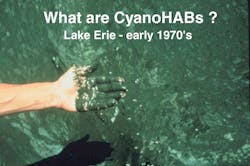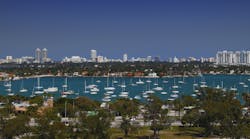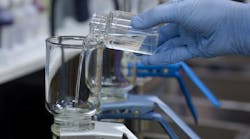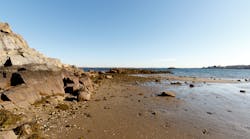According to a 2020 report by the Society of Environmental Journalists, algae “threatens public health, kills property values, wreaks havoc on tourism, drives up water rates, stymies economic development, hurts your region’s morale, mars its reputation, has psychological impacts, is a symptom of climate change, poor land use, government ineptitude, overpopulation and—frankly—just looks gross.”
The problems presented by cyanoHABs are driven by eutrophication, a word derived from the Greek meaning “well-nourished.” Eutrophication is usually defined as being an excess of nutrients, but the real problem stems from the competitive advantage cyanobacteria can exploit in eutrophic water bodies to become the most “well-nourished” organisms in the ecosystem.
In the absence of effective multilevel solutions to eutrophication, the problem of cyanoHABs has become firmly entrenched in many of our inland waters. Management methods that only focus on one technique; for example, using herbicides and algaecides to kill off the excessive biomass produced in blooms; cause massive cell breakdown and release of toxins and odors followed by the dead biomass decomposing and creating an oxygen deficit. Over time, this creates a sediment nutrient stockpile that is endlessly recycled in eutrophic water bodies.
It has been fifty years since the term eutrophication became part of the common language in referencing the cyanobacteria blooms and water quality in the Great Lakes and Lake Erie in particular. Since then, much effort and money has been spent on HAB “monitoring and detection” giving us a good perspective on the occurrence and distribution of both the organisms and their toxins (i.e., the cyanotoxins and other secondary metabolites).
Why are CyanoHABs a Problem?
Researchers first began to explain water pollution linked with eutrophication and cyanobacteria in the 1970s (Shapiro 1970, 1973).
Over this time period, cyanobacteria water blooms have been continuously linked to nutrient enrichment, especially in the Great Lakes, (Reutter 2019) and again more recently in the 1990s (Carmichael 2003, Scavia et al. 2014, Watson et al. 2016). We now know that when eutrophic conditions prevail in source water bodies like rivers, ponds, lakes and reservoirs, cyanobacteria can proliferate to produce what are known as HABs. Blooms are potentially harmful because many types of cyanobacteria produce a variety of potent cyanotoxins.
These toxins can sicken and kill wild and domestic animals, as well as humans, upon exposure, ingestion and inhalation, as was seen in Brazil in 1996 (Carmichael et al. 2001); or cause drinking water closures as happened in Toledo, Ohio, in 2014; Salem, Oregon, in 2018; and West Palm Beach, Florida, in 2021. “Do-not Drink” warnings are issued in these circumstances, and entire cities may become dependent on bottled water or water trucked in by tankers. There can be no argument that tap water made unsafe to drink by chemicals, pathogens or cyanotoxins represents a crisis.
The threat of cyanotoxins produced by cyanoHABs also leads to water bodies being closed to the public for recreational use. This has severe consequences for local economies and lakeside property values.
Veterinarians first noted that animals were dying after drinking from green watering points in the late 1800s (Australia), the 1930s (South Africa) and again in the 1950s (Canada and the US). I began my research with cyanoHABs and cyanotoxins using waterbloom samples from the Canadian prairie provinces of Alberta and Saskatchewan in 1970. By the early 1980s, I had found evidence for several chemical and functional groups of cyanotoxins, especially the potent cyclic peptide liver toxins named the microcystins, which was initially produced by the colonial single-celled cyanobacteria Microcystis aeruginosa (Carmichael 1997).
During this 50-year period, toxic cyanoHABs have become more prevalent, more intense and more enduring around the world. In the US, this is evidenced in several ways, including:
- Increasing numbers of lakes and reservoirs closed to the public by health authorities earlier every summer for longer periods of time.
- Waterways and beaches in Florida facing closures due to toxic HABs (both marine and freshwater), severely impacting the tourism industry.
- Rivers increasingly becoming transport conduits for cyanoHABs. Examples include the rivers feeding Monterey Bay, California; Ohio’s Maumee River contaminating Lake Erie; Lake Okechobee in Florida moving cyanoHABs to coastal beach areas; and the Mississippi River, which is increasingly a major source of contamination both inland and in the Gulf’s coastal waters.
The future trajectory of the cyanoHAB risk will only continue to go up, for a number of reasons. Lakes in the mid-west have suffered more from invasive weeds than cyanoHABs to date, and this was also the case in the northeast a decade ago. Researchers are now reporting that Midwest lakes (i.e., Michigan) are showing a progressive shift that is similar to changes seen in the northeastern states before cyanobacteria became so dominant there.
RELATED: Dropping By #69: How Increasing Temperatures Impact Algal Blooms
Insufficient Current Practices
Attempts to prevent eutrophication tend to focus on manipulating water nutrient chemistry, mainly by trying to reduce levels of dissolved phosphorus (P) and nitrogen (N) in the water. The main interventions to date have involved attempts to:
- Reduce nutrient inflows
Once the process of eutrophication has begun and sediment nutrient stockpiles start to accumulate, it is too late to expect that we can stop the process by simply reducing further nutrient inflows. This is because nutrient recycling from the sediment stockpile becomes self-sustaining for cyanobacteria.
- Chemically precipitate P into the sediment
Alum has been the main chemical used to precipitate P out of the water column, into the sediment. By doing so, P that was available at the surface for uptake by free-floating algae is removed from the surface water and dumped into the sediment nutrient stockpile. This is exactly where the cyanobacteria want it.
In many states, the use of alum has been banned and more expensive, less noxious products are now promoted in its place. Unfortunately, this just means it is costing more to achieve the same harmful effects.
Symptomatic Treatments & Long-term Relief
When everything we have done to try to arrest the spread of eutrophication and toxic cyanoHABs has actually made them worse, we start to develop a mindset that accepts the inevitability of toxic cyanoHABs. If there are going to be fires igniting everywhere, then it seems logical to adopt monitoring and detecting strategies, so that we know when to panic and call the fire brigade. The focus therefore shifts to post hoc or after-the-fact reactive interventions, every time a problem flares up.
- Algaecides & Herbicides
As nutrient-rich sediment accumulates, it provides an ideal rooting bed for invasive macrophytes (often called weeds). These weeds start to displace the native, more diverse aquatic plants that normally grow on the sandy bottom and provide a better spawning ground for fish to lay their eggs.
Because nutrients are also mobilized from this sediment to fuel algae and cyanobacteria blooms, we resort to algaecides and herbicides. They kill off the weeds and algae, but this creates two problems:
- A stress response can induce toxin release by cyanobacteria; and
- The dead weeds and algae sink to the bottom, decompose and add to the sediment nutrient stockpile that fuels future blooms.
- Ultrasound Devices
Another technique to deal with toxic cyanoHABs after they have formed is to use ultrasound to kill the cyanobacteria by destroying their cells. As well as creating the same two problems as algaecides, ultrasound has been shown to impair important zooplankton like Daphnia (Lürling and Tolman 2014) and other organisms. This degrades the food web, directly benefiting cyanobacteria.
- Skimming and harvesting
Sometimes used as a last-ditch effort, surface scums are physically skimmed off for deposit offsite (Finn 2019). The problem then becomes finding somewhere to safely dump the toxic harvest. This process must be repeated often, sometimes weekly or monthly, and does not significantly reduce the nutrient burden that created the problem.
Rethinking the Approach is Key to Kicking the HAB Habit
As toxic cyanoHABs become more prevalent, intense and enduring, it is time to rethink our approach. One-step solutions have proven insufficient, but a growing body of successful implementations suggests a system using a multistep (holistic) treatment can place lakes and reservoirs on a new trajectory.
Case Study: Lake Peekskill, Putnam Valley, New York
Lake Peekskill is a 60-acre lake about 60 miles (100km) north of New York City in the town of Putnam Valley. After the lake was declared unsafe for human use over several summers, an RFP was issued in 2017 for a team to help alleviate the toxicity. Key criteria for acceptance of the proposal were that no chemicals not natural to the system (i.e., algicides or alum) would be used.
SIS.bio and their USA sister company Clean-Flo International were selected by Putnam Valley based on their comprehensive, ecological solution, incorporating aeration and enzymes, nutrients and competitive pricing.
The SIS.bio solution does not seek to “kill” the cyanobacteria or bluegreen algae that are responsible for toxic cyanoHABs but rather to support the natural re-establishment of a competitive productive food web so that the cyanobacteria are reigned in through natural competition for available nutrients, thus achieving greater biodiversity and a better balance.
Prior to commissioning the solution, on June 20, 2018, the desired minimum of 5mg/l Dissolved Oxygen (DO) was barely present from 15 feet deep. Nine weeks later (and to this day) the entire water column was destratified and reoxygenated to 23 feet.
Reoxygenating the entire water column opens up water volume for fish and other oxygen-breathing aquatic life that could not otherwise inhabit it. This environment re-establishes a productive food web to take up nutrients and deny them to cyanobacteria.
“The system is now in its fourth year with the lake in pristine condition, full of the aquatic life it had back in the 1960s,” said Sam Oliverio (former supervisor Town of Putnam Valley, New York).
Conclusion
With revised use of existing methods, applied in a multilevel way, we now have field examples showing remediation leading to prevention. This was accomplished through a better understanding of why cyanobacteria come to dominate our water supplies. The next 50 years can be about reducing and removing nutrient laden sediments in lakes, reservoirs, rivers and estuaries using a multilevel approach involving air/water flow, complemented with bioaugmentation and selected nutrients.
This reduction in sediments increases water volume and moves nutrients into food webs that are beneficial. By doing so, not only will we be kicking the HAB habit, but we will replace it with a process that has the potential to restore our lakes and waterways closer to the condition they were in, prior to nutrient overloading.
About the author:
Wayne Carmichael, professor emeritus, Wright State University, is a retired (2007) Professor of Biological Sciences and Professor Emeritus at Wright State University, Dayton, Ohio. An Oregon native he received his B.Sc. in Botany/Zoology from Oregon State University-1969; and an M.Sc-1972 and Ph.D.-1974, in limnology, aquatic microbiology and pharmacology from the University of Alberta, Edmonton, Alberta. His professional career was spent on primary research of cyanobacteria freshwater harmful algae blooms. Projects as a professor emeritus focus on management, mitigation, remediation and prevention of harmful cyanobacteria in municipal and recreational water supplies. This includes serving on national and international HAB committees, organization of and participation in workshops and symposia plus advising on HAB issues for local, state, national and international agencies and groups. He now makes his home in the coast range of Northern Oregon, on the beautiful Nehalem River.
REFERENCES
- Carmichael, W. W. (1997). The cyanotoxins. Advances in botanical research, 27, 211-256.
- Carmichael, W.W. (2003). Reemergence of Cyanobacterial harmful algae blooms in the Great Lakes – The CyanoHABs. Lake Erie Millennium Network – Third Biennial Conference. The Univ of Windsor, Ontario- May 6-7, 2003. (invited presenter)
- Carmichael, W. W., Azevedo, S. M., An, J. S., Molica, R. J., Jochimsen, E. M., Lau, S., Rinehart, K. L., Shaw, G. R., & Eaglesham, G. K. (2001). Human fatalities from cyanobacteria: chemical and biological evidence for cyanotoxins. Environmental health perspectives, 109(7), 663-668.
- Finn, L. (2019). https://patch.com/new- york/southampton/new-pilot-program-tackle-harmful- algal-blooms-lake-agawam
- Lürling, M. F. L. L. W., & Tolman, Y. (2014b). Effects of commercially available ultrasound on the zooplankton grazer Daphnia and consequent water greening in laboratory experiments. Water, 6(11), 3247-3263. https://doi.org/10.3390/w6113247
- Reutter, J. M. (2019). Lake Erie: past, present, and future. Encyclopedia of Water: Science, Technology, and Society, 1-15.
- Scavia, D., Allan, J. D., Arend, K. K., Bartell, S., Beletsky, D., Bosch, N. S., Brandt, S. B., Briland, R. D., Daloğlu, I., DePinto, J. V., Dolan, D.M., Evans, M. A., Farmer, T. M., Goto, D., Han, H., Höök, T. O., Knight, R., Ludsin, S. A., Mason, D., Michalak, A. M., Richards, R. P., Roberts, J. J., Rucinski, D. K., Rutherford, E., Schwab, D. J., Sesterhenn, M., Zhang, H., & Zhou, Y. (2014). Assessing and addressing the re-eutrophication of Lake Erie: Central basin hypoxia. Journal of Great Lakes Research, 40(2), 226-246.
- Shapiro, J. (1970). A statement on phosphorus. Journal of Water Pollution Control. 42(5), 772-775.
- Shapiro, J. (1973). Blue-green algae: why they become dominant. Science, 179(4071), 382-384.
- Watson, S. B., Monis, P., Baker, P., & Giglio, S. (2016). Biochemistry and genetics of taste-and odor-producing cyanobacteria. Harmful Algae, 54, 112-127.
Editor's note: A previous version of this article misidentified the location of Putnam Valley. The article has been updated to the correct location of New York.






